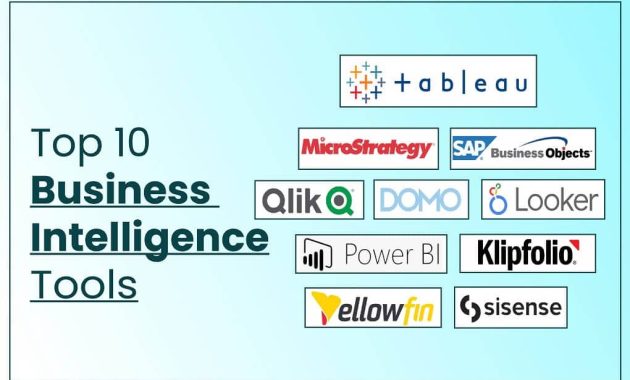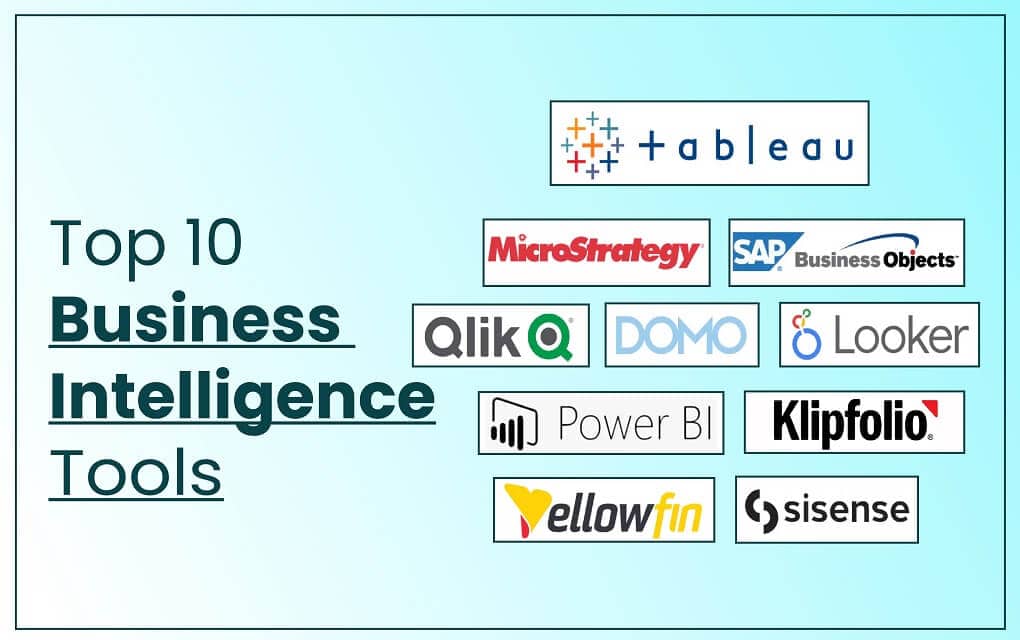
The Ultimate Guide to 7 Business Intelligence Tools: Staying Ahead of the Curve
In today’s data-driven world, businesses are constantly seeking ways to gain a competitive edge. The ability to understand and leverage data is no longer a luxury—it’s a necessity. This is where Business Intelligence (BI) tools come into play. They transform raw data into actionable insights, empowering organizations to make informed decisions. This guide provides an in-depth look at 7 of the most effective business intelligence tools, helping you understand their capabilities and how they can benefit your business. Choosing the right business intelligence tool is a critical strategic decision. This guide is your starting point.
Understanding the Power of Business Intelligence
Business intelligence goes beyond simple reporting. It involves collecting, analyzing, and interpreting data to reveal patterns, trends, and insights. These insights then guide strategic decisions, improve operational efficiency, and enhance customer experiences. By using business intelligence tools, businesses can:
- Identify market trends and customer preferences.
- Optimize operational processes for efficiency.
- Improve decision-making with data-backed insights.
- Enhance customer satisfaction.
- Increase revenue.
The evolution of business intelligence has been remarkable. Early systems focused on basic reporting. Now, the focus is on real-time data analysis and predictive analytics. This shift allows businesses to proactively anticipate future challenges and opportunities. This proactive approach is crucial for sustained success.
Key Features to Look for in a Business Intelligence Tool
Before diving into specific tools, it’s important to understand the key features that define a robust business intelligence tool. Consider these core functionalities:
- Data Integration: The ability to connect to various data sources. This includes databases, cloud services, and spreadsheets.
- Data Visualization: Tools to create charts, graphs, and dashboards. These visuals make data easier to understand.
- Reporting and Analysis: Features for generating reports. Also, conduct in-depth data analysis.
- Data Mining: Capabilities for discovering patterns and trends within large datasets.
- Interactive Dashboards: Real-time dashboards that provide a comprehensive view of key performance indicators (KPIs).
- Mobile Access: The ability to access data and dashboards from mobile devices.
- User-Friendly Interface: An intuitive interface that makes the tool easy to use for users of all technical skill levels.
The 7 Essential Business Intelligence Tools
Here is a detailed overview of seven leading business intelligence tools. Each tool offers unique strengths and caters to different business needs. Consider your specific requirements when making your choice.
Tableau
Tableau is a widely recognized leader in the business intelligence space. It is known for its intuitive interface and powerful data visualization capabilities. Tableau allows users to create interactive dashboards and reports with ease. It supports a wide range of data sources. Its drag-and-drop functionality makes it easy for non-technical users to explore data. Tableau’s strong community support and extensive training resources make it a popular choice.
- Key Features: Drag-and-drop interface, interactive dashboards, data blending, and extensive data connectors.
- Pros: User-friendly, excellent visualization capabilities, strong community support.
- Cons: Can be expensive, especially for larger organizations.
Microsoft Power BI
Microsoft Power BI is a powerful and cost-effective business intelligence tool. It seamlessly integrates with other Microsoft products. It offers a comprehensive suite of features for data analysis and visualization. Power BI is accessible to a wide range of users. It offers a free version. Power BI is ideal for businesses already invested in the Microsoft ecosystem. It allows for easy data integration and sharing.
- Key Features: Integration with Microsoft products, data modeling, interactive dashboards, and natural language query.
- Pros: Affordable, integrates well with Microsoft products, user-friendly.
- Cons: Can be less intuitive for complex data analysis compared to some competitors.
Qlik Sense
Qlik Sense is a business intelligence tool that excels in data discovery and exploration. It uses an associative data model. This model allows users to explore data relationships intuitively. Qlik Sense offers self-service analytics. It empowers users to create their own dashboards and reports. The tool’s advanced analytical capabilities make it a strong choice for complex data analysis. This is a powerful choice for complex data analysis.
- Key Features: Associative data model, self-service analytics, advanced analytics, and data storytelling.
- Pros: Strong data exploration capabilities, intuitive data discovery.
- Cons: Can have a steeper learning curve than some other tools.
Looker (Google Cloud)
Looker, now part of Google Cloud, is a business intelligence tool focused on data modeling and governance. It provides a centralized platform for defining and managing data. Looker is well-suited for organizations with complex data structures and a strong emphasis on data accuracy. Looker’s data modeling capabilities promote consistency across the organization. This promotes data-driven decision-making.
- Key Features: Data modeling, centralized data governance, real-time dashboards, and integration with Google Cloud.
- Pros: Strong data governance, powerful data modeling capabilities.
- Cons: Can be complex to set up and manage.
Sisense
Sisense is a business intelligence tool known for its ease of use and scalability. It is designed to handle large datasets and complex analytics. Sisense allows users to embed analytics into their applications. This creates a seamless data experience. Sisense is a good choice for businesses that require real-time data analysis. It is also great for those with many users.
- Key Features: Scalability, in-app analytics, data preparation, and real-time data analysis.
- Pros: Excellent scalability, easy to embed analytics.
- Cons: Can be expensive, especially for smaller businesses.
Zoho Analytics
Zoho Analytics is a cloud-based business intelligence tool. It is designed for small to medium-sized businesses. It offers a user-friendly interface and a range of pre-built integrations. Zoho Analytics is a cost-effective option. It provides a comprehensive set of features for data analysis. It is also great for visualization.
- Key Features: User-friendly interface, pre-built integrations, data blending, and data visualization.
- Pros: Affordable, easy to use, and good for small businesses.
- Cons: May lack some advanced features compared to other tools.
SAP Analytics Cloud
SAP Analytics Cloud is a comprehensive business intelligence tool. It is designed for enterprise-level organizations. It offers a wide range of features. These features include planning, predictive analytics, and data visualization. SAP Analytics Cloud integrates with SAP systems. This makes it ideal for businesses using SAP. SAP Analytics Cloud supports advanced analytics. It also supports planning and collaboration.
- Key Features: Planning, predictive analytics, data visualization, and integration with SAP systems.
- Pros: Comprehensive feature set, strong integration with SAP.
- Cons: Can be complex to implement and manage.
Choosing the Right Tool for Your Business
Selecting the right business intelligence tool is a critical decision. It depends on your specific business needs and goals. Consider the following factors when making your choice:
- Data Sources: The types of data sources you need to connect to.
- Budget: The cost of the tool, including licensing and implementation.
- Technical Skills: The technical expertise of your team.
- Scalability: The tool’s ability to handle your data volume as your business grows.
- Features: The specific features you need, such as data visualization and advanced analytics.
By carefully evaluating these factors, you can choose a business intelligence tool that empowers your business. This will help you make data-driven decisions. This will also help you gain a competitive advantage.
Implementation Best Practices
Once you’ve chosen a business intelligence tool, successful implementation is key. Follow these best practices:
- Define Your Goals: Clearly define what you want to achieve.
- Clean and Prepare Your Data: Ensure data accuracy.
- Train Your Team: Provide adequate training.
- Start Small: Begin with a pilot project.
- Monitor and Evaluate: Continuously monitor.
Proper implementation ensures that you maximize the value of your business intelligence tool. It also ensures you achieve your business objectives.
The Future of Business Intelligence
The future of business intelligence is bright. We can expect to see several key trends:
- Artificial Intelligence (AI) and Machine Learning (ML): AI and ML will play a larger role.
- Automation: Automation will streamline data analysis.
- Data Democratization: More people will have access to data.
- Cloud-Based Solutions: Cloud-based tools will become more prevalent.
These trends will empower businesses to gain deeper insights. They will also help businesses make better decisions.
Conclusion
Choosing the right business intelligence tool is a strategic decision. The tools discussed in this guide offer powerful capabilities. They help businesses stay competitive in today’s data-driven landscape. By understanding your business needs and carefully evaluating the available options, you can select a tool. This tool will empower your organization to unlock the full potential of its data. This is your first step to success in the world of business intelligence. Embrace the power of data. This will drive innovation and achieve sustained growth. [See also: How to Implement a BI Strategy] [See also: The Benefits of BI for Small Businesses] [See also: Data Visualization Best Practices]

